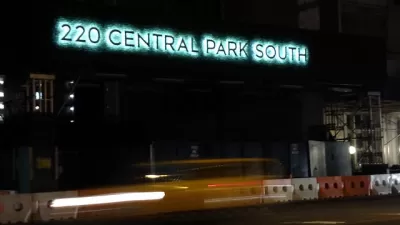The New York Times ran a massive feature documenting the rise of foreign real estate investment in New York City, enabled by the anonymity of limited liability corporations.
The New York Times focuses on the Time Warner Center near central Park in New York as "the New York archetype of the global phenomenon, reflecting intertwined trends — the increasing sums of foreign money in high-end real estate and the growing use of shell companies."
"Behind the dark glass towers of the Time Warner Center looming over Central Park, a majority of owners have taken steps to keep their identities hidden, registering condos in trusts, limited liability companies or other entities that shield their names. By piercing the secrecy of more than 200 shell companies, The New York Times documented a decade of ownership in this iconic Manhattan way station for global money transforming the city’s real estate market."
The investigative work of the Times team reveals some of the unsavory characters using the New York luxury housing market to stash assets, but also points out the consequences of the trend. For instance, any argument in favor of a "trickle-down effect" is moot when property owners are rarely found in the country.
Moreover, the city implemented generous property tax incentives in its rush to attract billionaires: "As nonresidents, they pay no city income taxes and often receive hefty property tax breaks. A program aimed at new condo development doles out about a half-billion dollars in tax breaks a year, according to the city’s independent budget office. These savings are passed on to owners in the form of lower property taxes. The Time Warner Center was not part of the most lucrative tax break program, but many other buildings around Central Park have benefited."
The article includes a series of graphic visualizations, illustrating the trend of foreign investment in New York City as a whole, the country as a whole, and the Time Warner Center as a case study.
The long article, with a lot more investigative work and storytelling about some of the individuals that own property in Time Warner Center, includes at least one recommendation for what to do about it all: "A proposal from the Fiscal Policy Institute would impose a graduated tax on pieds-à-terre worth $5 million or more. The group estimates it would generate $665 million a year in revenue for the city, mostly from owners of the approximately 445 apartments valued at more than $25 million."
FULL STORY: Stream of Foreign Wealth Flows to Elite New York Real Estate

Study: Maui’s Plan to Convert Vacation Rentals to Long-Term Housing Could Cause Nearly $1 Billion Economic Loss
The plan would reduce visitor accommodation by 25,% resulting in 1,900 jobs lost.

North Texas Transit Leaders Tout Benefits of TOD for Growing Region
At a summit focused on transit-oriented development, policymakers discussed how North Texas’ expanded light rail system can serve as a tool for economic growth.

Why Should We Subsidize Public Transportation?
Many public transit agencies face financial stress due to rising costs, declining fare revenue, and declining subsidies. Transit advocates must provide a strong business case for increasing public transit funding.

How to Make US Trains Faster
Changes to boarding platforms and a switch to electric trains could improve U.S. passenger rail service without the added cost of high-speed rail.

Columbia’s Revitalized ‘Loop’ Is a Hub for Local Entrepreneurs
A focus on small businesses is helping a commercial corridor in Columbia, Missouri thrive.

Invasive Insect Threatens Minnesota’s Ash Forests
The Emerald Ash Borer is a rapidly spreading invasive pest threatening Minnesota’s ash trees, and homeowners are encouraged to plant diverse replacement species, avoid moving ash firewood, and monitor for signs of infestation.
Urban Design for Planners 1: Software Tools
This six-course series explores essential urban design concepts using open source software and equips planners with the tools they need to participate fully in the urban design process.
Planning for Universal Design
Learn the tools for implementing Universal Design in planning regulations.
City of Santa Clarita
Ascent Environmental
Institute for Housing and Urban Development Studies (IHS)
City of Grandview
Harvard GSD Executive Education
Toledo-Lucas County Plan Commissions
Salt Lake City
NYU Wagner Graduate School of Public Service




























